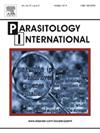Epidemiology of Plasmodium spp. gametocyte carriage in Delhi, India
IF 1.5
4区 医学
Q3 PARASITOLOGY
引用次数: 0
Abstract
Malaria transmission is fuelled by the development stages called gametocytes. Prevalence, patterns, and determinants of gametocyte carriage, a silent and understudied public health issue, were evaluated in Delhi, India. Between August 2022 and September 2023, a cross-sectional study was conducted at a reference hospital. Gametocyte detection was performed by light microscopy. Of the 4259 febrile patients included, gametocytes were found at a prevalence of 1.3 %, with a predominance of P. vivax (78.6 %). Higher risks of P. falciparum gametocyte carriage were found in individuals with increased levels of platelet count -PCT (aOR = 10.66 to 12.82, p < 0.05), C-reactive protein-CRP (aOR = 4.11 to 6.16, p < 0.05), and red blood cells-RBC (aOR = 6.78, p = 0.005), whereas increased haemoglobin (Hb) was protective (aOR = 0.56, p = 0.002). Similar patterns were found for P. vivax gametocyte carriage, in addition to the effect of the malaria transmission period (aOR = 2.89, p = 0.01). This study pinpoints a low Plasmodium spp. gametocyte carriage, with a consistent influence of CRP, PCT, Hb, and malaria transmission. These findings might provide baseline information for targeting gametocyte carriers to block malaria transmission in the area.
印度德里地区疟原虫配子细胞携带的流行病学
疟疾传播是由称为配子体的发育阶段推动的。配子体携带的流行、模式和决定因素是一个沉默和未充分研究的公共卫生问题,在印度德里进行了评估。在2022年8月至2023年9月期间,在一家参考医院进行了一项横断面研究。光镜下检测配子细胞。在纳入的4259例发热患者中,配子细胞患病率为1.3%,间日疟原虫占优势(78.6%)。血小板计数-PCT水平增高的个体携带恶性疟原虫配子细胞的风险较高(aOR = 10.66 ~ 12.82, p <;0.05), c反应蛋白- crp (aOR = 4.11 ~ 6.16, p <;红细胞-红细胞(aOR = 6.78, p = 0.005),而血红蛋白(Hb)升高具有保护性(aOR = 0.56, p = 0.002)。间日疟原虫配子体携带模式与疟疾传播期的影响相似(aOR = 2.89, p = 0.01)。本研究确定了低疟原虫配子细胞携带,与CRP, PCT, Hb和疟疾传播的一致影响。这些发现可能为靶向配子体携带者阻断疟疾在该地区的传播提供基础信息。
本文章由计算机程序翻译,如有差异,请以英文原文为准。
求助全文
约1分钟内获得全文
求助全文
来源期刊

Parasitology International
医学-寄生虫学
CiteScore
4.00
自引率
10.50%
发文量
140
审稿时长
61 days
期刊介绍:
Parasitology International provides a medium for rapid, carefully reviewed publications in the field of human and animal parasitology. Original papers, rapid communications, and original case reports from all geographical areas and covering all parasitological disciplines, including structure, immunology, cell biology, biochemistry, molecular biology, and systematics, may be submitted. Reviews on recent developments are invited regularly, but suggestions in this respect are welcome. Letters to the Editor commenting on any aspect of the Journal are also welcome.
 求助内容:
求助内容: 应助结果提醒方式:
应助结果提醒方式:


